Being Seen
Behind the scenes
Introduction to Viva Las Vegas
In 2004 and 2005 Koster took short vacations to Las Vegas to attend the Viva Las Vegas hot rod and rockabilly car culture event. Although it was a vacation, Koster couldn’t resist bringing along a 35mm camera to capture some informal lifestyle shots.
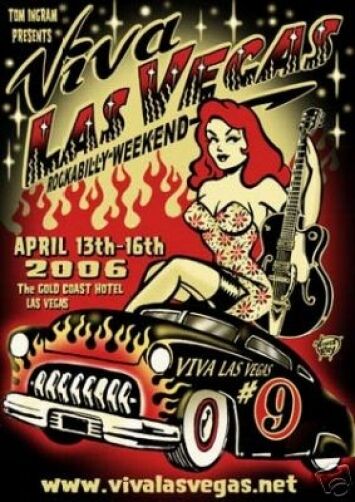
Flier from 2006 Viva Las Vegas hot rod and rockabilly event in Las Vegas.
Koster: Except for the bands that played inside the hotel, much of the event at the time took place on top of the parking garage at the Gold Coast Hotel. It was sunny and warm, very Vegas. The event was generally shoulder to shoulder with people milling about vintage-themed hotrod cars and vendor booths. The people were mostly inked up and had some form of hotrod, rockabilly or vintage-themed attire. The crowd was very entertaining, even better than the airport. Many of the ladies carried parasols, which I thought was pretty cool. The crowd came from all over the country. Lots of New York, California, New Mexico and Texas plates. It was a total party.
As I was shuffling along with the crowd, I saw this woman coming towards me. The event was full of what I would call photo-candy but, she really stood out. When I reached her I asked if I could take her picture. She said yes like it wasn’t the first time someone had asked to take her picture that day. So right there in the thick of the crowd, I strategically sidestepped to my left so when she rotated towards me the direct sun was off her face. She now had her back to the sun. Her parasol lit up and wow! As soon as I took the first shot she turned and continued on her way. I was a bit disappointed, but had to remind myself this wasn’t a photo shoot and she was probably on her way somewhere. When I got back home and was looking at my film, it was this image that made me think maybe this car culture crowd might make for a pretty interesting portrait series. An official portrait series shot with a better camera. Something with intention and not just quick snapshots with the 35mm camera. I guess you could say that is how the “Being Seen” series started.
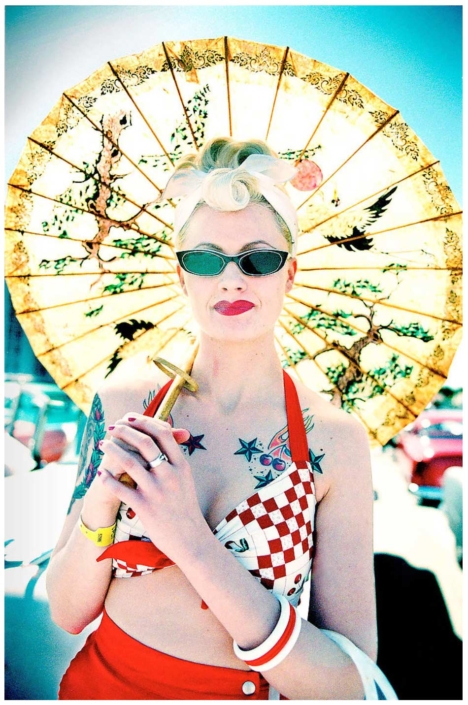
Portrait shot on 35mm film by Jason Koster at 2005 Viva Las Vegas.
I reached out to the event coordinator and got permission to set up a little portrait station in one of the 10 x 10 vendor spots at the 2006 event. It was a small space to work in, on top of a parking garage, heckled by passers-by, in the blasting sun. Perfect portrait environment! (laughs) I shot on my medium format 6×7 camera. No luxury of auto focus but, the quality upgrade from 35mm is noticeable. This was definitely not the kind of environment I wanted to bring expensive lights to but, I did bring what we in the photo industry call light modifiers. I wasn’t applying light to my subjects but rather sculpting the sunlight that was already there.
Introduction to Burning Man
Koster spent the entire 2006 Viva Las Vegas weekend photographing as many people as he could. A few weeks later while reviewing the images back at home with a colleague, John Romero, Koster noticed he was most engaged with the images where the subject was not posing or putting on some kind of act. Struggling to find the right words in the discussion he referred to them as ‘honest’, ‘raw’. Romero responded, “If it’s raw you’re looking for, then you should go to Burning Man.” On the advice of his colleague Koster started to research the Burning Man event.
In short, Burning Man is an extreme, outdoor, self-expression festival that takes place in late August, 120 miles northeast of Reno, Nevada on a dry lake bed in the Black Rock Desert. The event space is seven square miles. Tickets are several hundred dollars. The average age is 40. In 2006 there were about 40,000 attendees. (2024 had 70,000 attendees) Burning Man functions on a pack-it-in, pack-it-out, leave-no-trace, radical self-reliance concept. There are no vendors and participants are not allowed to sell anything. The only things for sale are by the Burning Man organization: coffee, tea and ice. Otherwise it is a gift or trade economy. The event is known for its white-out dust storms, diverse large scale art, art cars, art bicycles, fire, dance, fire dancers, music, booze, costuming, optional clothing, minimal rules and clever humor. The event opens at midnight on a Sunday and closes one week later on the following Sunday. The main event happens on Saturday night with the burning of the man – a 100-foot wooden effigy. The ceremony is a huge letting go/rebirth celebration with an impressive firework show and of course a huge fire.

Black Rock Desert 120 miles from Reno, NV.
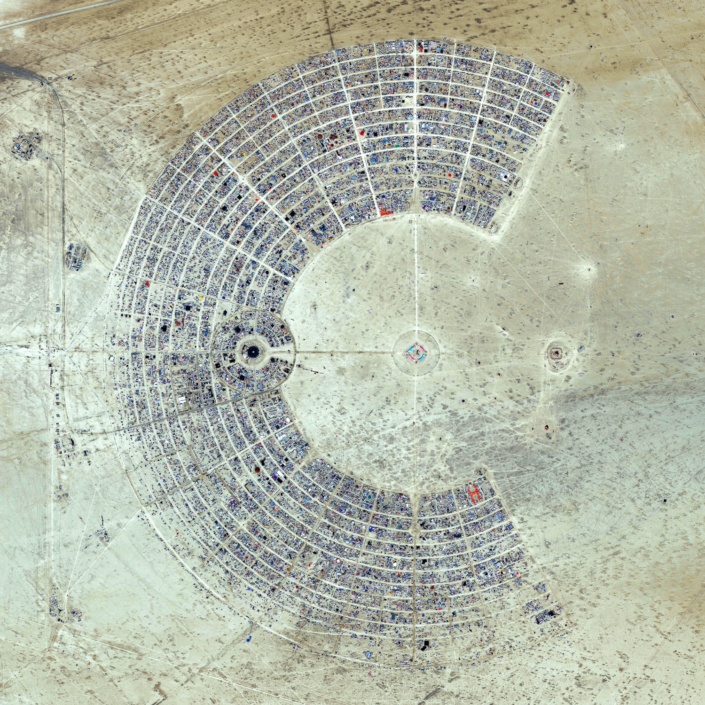
Satellite view of Burning Man. The ‘C’ shape is dispersed camping. The dot in the middle is ‘the man’. The dot to the right of the man is the Temple. The dark dot in the dispersed camping to the left of the man is Center Camp, a community space. Both Center Camp and the Temple are each one mile from the man. The lines in the dispersed camping are streets. For navigation sake the ‘rings’ are labeled alphabetically and the ‘rays’ have a clock orientation. The street going straight up from the man is nine 0’clock. The line going straight down is three o’clock. Then progress in thirty minute increments.
Koster at Burning Man
Koster reached out to the Burning Man event coordinators, filled out the media request paperwork explaining his personal art project and got permission to take portraits at the 2006 burn.

A few of Koster’s media passes that have survived over the years.
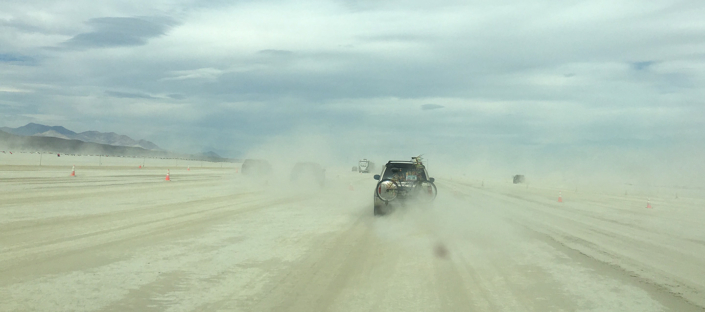
Koster arrives at Burning Man.

Koster photographing on the playa with his 6×7 medium format film camera, camera bag, model release clipboard and borrowed bike from colleague, John Romero.
Koster: Just getting to Burning Man is a huge undertaking. Participants spend months in advance getting ready. Preparing costumes, bikes, art, gifts, decorations, accommodations, meal plans, etc. It is a labor of love. You generally don’t want to bring anything too nice or valuable because of the dust storms. The remoteness of the playa is daunting. There is no running to the store if you forgot something. It takes a lot of planning to figure out how you are going to survive for a week on a dry lake bed. I chose to go low tech and stayed in a tent. My dinners were prepared at home before I left, vacuum sealed, frozen and kept on ice the best I could. I used the melted ice water in my cooler to boil the meal and eat right out of the bag. I didn’t even need clean water, and there were no dishes to deal with.
The biggest difference shooting at Burning Man was, at Viva Las Vegas I could use proper photography equipment to hold my light sculpting modifiers. I could drive my car right up to my shoot space to drop off my gear and supplies for the day. At Burning Man I needed to be a completely self-contained portrait studio on a bicycle. I needed to create a way to sculpt the light and also not leave myself heartbroken if it should get destroyed in a dust storm. I created a 48″ x 60″ collapsible black box made out of foam core. When collapsed I could secure it with a motorcycle strap that I used as a handle. With my camera bag over one shoulder and holding onto my portrait box under the other arm, I was able to ride with one hand to my destination. My preferred portrait locations were generally about 2-4 miles from my camp. Riding in a dust storm like this was challenging if not comical at times. (laughs) Unfortunately, it didn’t take much to blow a foam core box on the open playa and it became frustrating to try and work like this. Also a black foam core box in the sun made for quite the Easy-Bake Oven for my subjects. I eventually found the shady side of some large scale art that I could use as a wind and sun block.
The portrait box made a series of progressions each year. The following year I arrived with a portrait box made out of electrical conduit modified to assemble easily with minimal tools. I lined the inside of the box with black nylon that I tailored and covered the outside with silver bubble insulation. I would transport it disassembled but it was still a bit unruly. That’s when I got the baby trailer for my bike – game changer. The conduit portrait box was certainly a temporary structure but, it wasn’t very mobile. I just picked a spot and went with it. The conduit box year was the year I was trying to take someone’s picture and I noticed they were very distracted. I looked up from my camera and we were surrounded by people in bunny costumes. In fact right in the middle of about 500 people, in various bunny costumes, having a giant sword fight. That is also the year I learned about the annual bunny sword fight – which was kind of a big thing. It was fantastic but, I can’t take serious fine art portraits in the middle of a bunny sword fight. I ended up calling it a day. Before next year’s Burn I spent some time engineering a collapsible portrait box that attached to the baby trailer. I could set up or break down in about a minute. I was very proud of my engineering. Now I could ride around to where ever the scene felt good. I could also orient the portrait box to make the best use of the light. Riding against the wind was almost impossible, and I ended up re-gearing my single speed bike for towing. Small modifications were made after that until I moved onto the portrait box for what I am calling the hyper-white background. It was also a collapsible box attached to the baby trailer but it used the sunlight differently. That would be the final portrait box of the series.
Choosing Subjects at Burning Man
Koster: The funny thing about photographing people at Burning Man is it took a few days for people to get to the right mental space. You could see their heads were still back in the default world with their default world concerns. It wasn’t until people had endured several days of play in the elements that they finally started getting that blissful, far away, care free look about them. I would look for the people that had a peaceful, sleepwalking quality about them. I would approach them gently and say, when you are done here could you come over to that box for a portrait? Then I would leave them alone. Some came over and some didn’t. Asking someone twice felt like it was going against what I was looking for. I also found if I started conversing while photographing I could see them thinking, which I didn’t want. I remember early on asking someone to look serious, which of course just led to giggling. Also not what I was looking for, but that did help shape my approach to my subjects. From then on I was very gentle with requesting my subjects look focused into the lens. The engagement was amazing, but it usually only lasted about three frames of film. Then they would suddenly become very aware they were getting their picture taken and a guard would go up – the moment was gone and that’s ok. I always felt a little bad for waking them. I ended up photographing more women because it was refreshing to see them less concerned about glamor. They were dusty, crusty, sun-kissed and glowing with life.
I chose to work in black and white because I feel a lot of people tend to see color as subject. They might focus on the red that happens to be a barn instead of a barn that happens to be red. Speaking of red, I had just photographed a redhead in a yellow scarf. I tried to hand the two polaroids to her so she could choose which one she wanted to keep. She was very modest and didn’t even want to look, instead I let whom I assume was her husband choose. He gasped, “YOU BEAUTIFUL RASPBERRY!”. That has been my all time favorite response. I was so thrilled that he got what I was seeing.

Polaroids and model releases for both Viva Las Vegas and Burning Man. Koster would take two polaroids of each subject before shooting film. He would let the subject choose which one they wanted to keep and put the other one as a visual reference with the model release.
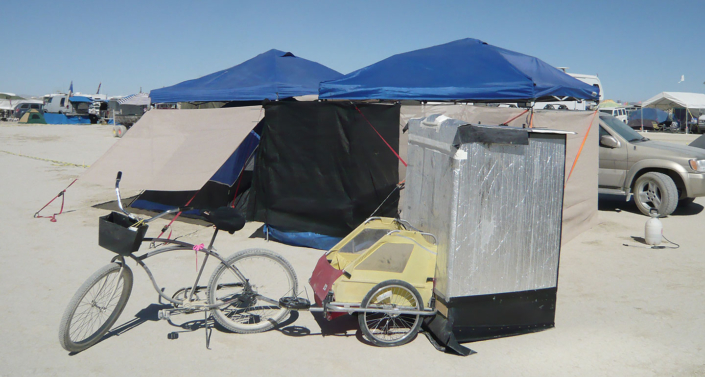
Koster’s mobile portrait rig on display in front of his Burning Man camp.
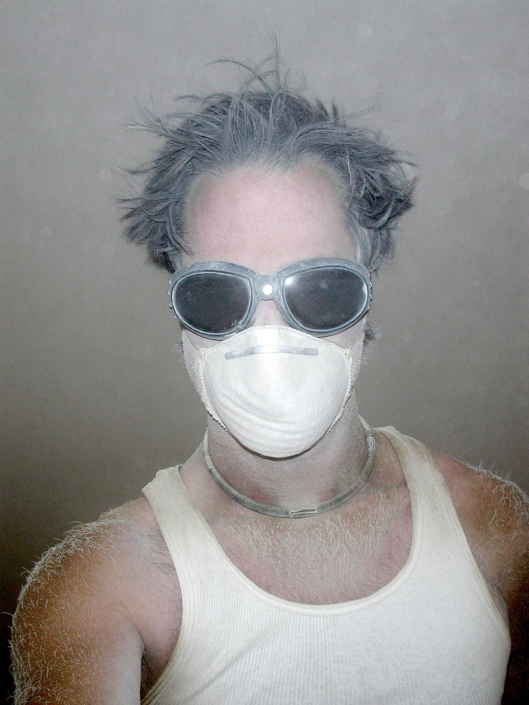
Koster in a mid day white-out dust storm.
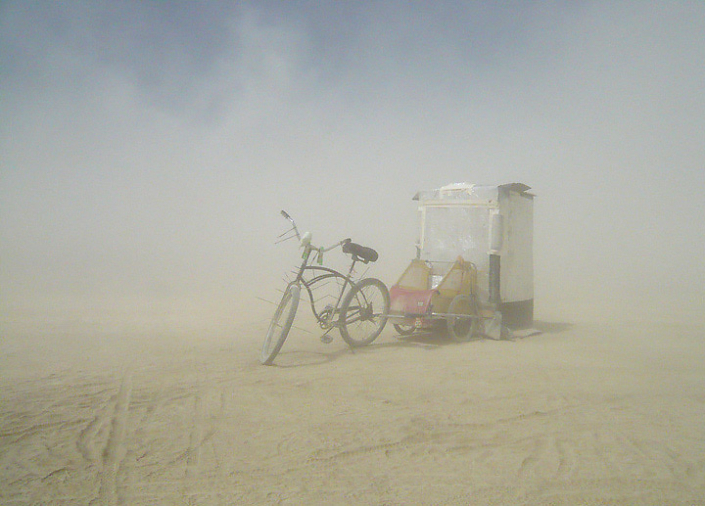
Koster’s mobile portrait rig in a dust storm at Burning Man.

Koster’s portrait rig visits the man at Burning Man.

Koster’s portrait rig poses for a portrait on the Burning Man playa.
The Homeless Youth
Koster: As I showed my portrait series, many people commented that most of my subjects look like they had been through something. A week on a dry lake bed will do that to a person.
In early 2010 I was asked to participate in a photography project called Picturing Maricopa – a county in Arizona. I was assigned to work with an organization called Tumbleweed – an organization that helps homeless and at risk youth. To be honest, it was an emotionally gut wrenching project. I would hear stories of kids being dropped off on the streets of downtown by a parent and being told not to come home, there is no home to come back to, ‘your father and I won’t be there’. After the project ended I went back to the main downtown location and set up my portrait box out front. I didn’t bother with the bike or the trailer. I just set the box on the ground. This was not a cute, whimsical environment. Most of these kids had been abused and betrayed by adults so they were very guarded. I had no idea if I was going to get any participants. From a safe distance I began asking kids if they would let me take their picture in my portrait box, gesturing toward it. Some kids quickly ran away which I tried not to think about, but some were intrigued by the idea of being involved in a photograph.
When ‘Roxy’ agreed to let me take her picture she just sat down on the ground with her backpack in her lap. I immediately framed up my camera and took that picture. Her backpack felt like a buffer between us so I moved in closer to minimize it. The pack became too difficult to work around so I asked if I could set it aside. Mid sentence I realized her backpack was probably everything she had in the world. I quickly adjusted my sentence to asking if I could move her pack right next to me, still in plain sight for her. The next shot felt like I was finally getting through, but somehow not quite right. I noticed her hair was pulled back pretty tight so I asked if she would let it down. She was hesitant but agreed. She shook her hair out and looked up at the camera. (Ahhh there you are.) An entirely different person – even if it is just for a moment. While taking the last shot I said something dorky like, ‘oh very pretty!’ then let her know we were done. She sprang up and went over to her backpack. Quickly put her hair back up and said, ‘It’s not always a good thing being pretty out here.’ – gave me a troubled look, grabbed her bag and ran off.

Roxy with backpack outside of Tumbleweed facility.
A New Look With
A New Portrait Box
Before the 2011 burn Koster decided it was time for a new look for the series which meant a new portrait box. The result would be the hyper-white background phase. A light and airy environment to compliment the vulnerability of the subjects as well as a juxtaposition to their current physical condition.
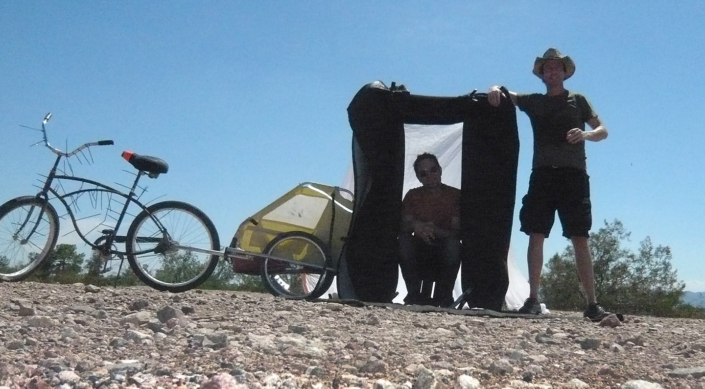

Koster and the late Steve Karr in the summer months before 2011 Burning Man working out the details for the new hyper white background portrait box.
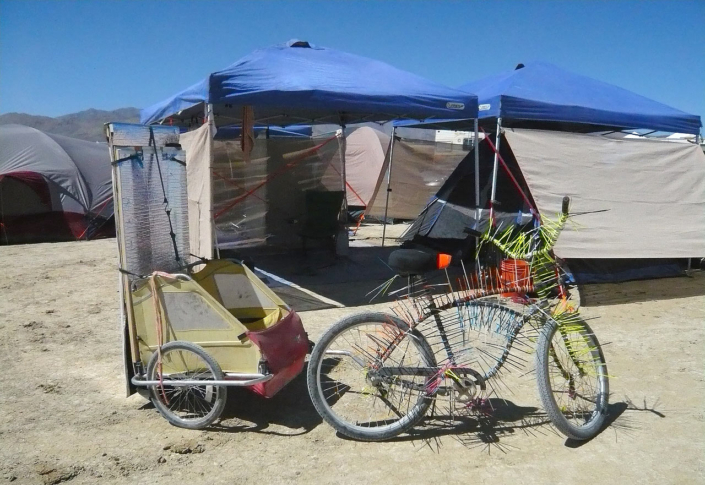
Koster’s hyper white portrait box rig packed up and ready to leave base camp for a day of portraits at Burning Man 2011

Koster’s hyper white portrait rig next to ‘the man’ at Burning Man 2011.
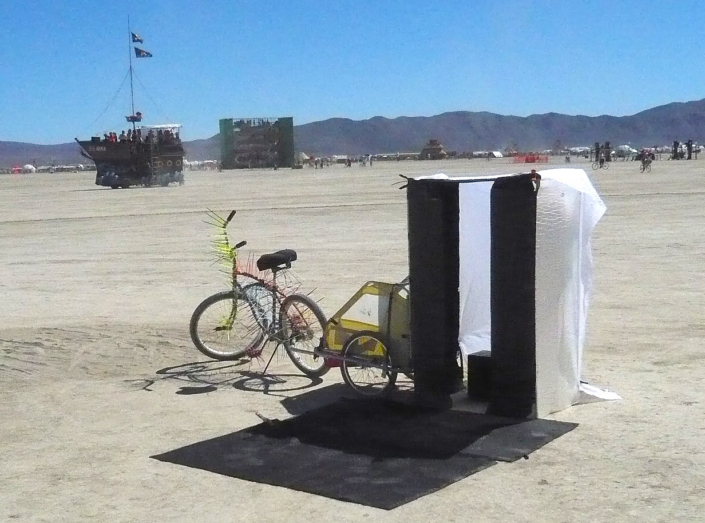
Koster’s hyper white portrait rig with pirate ship at Burning Man 2011.
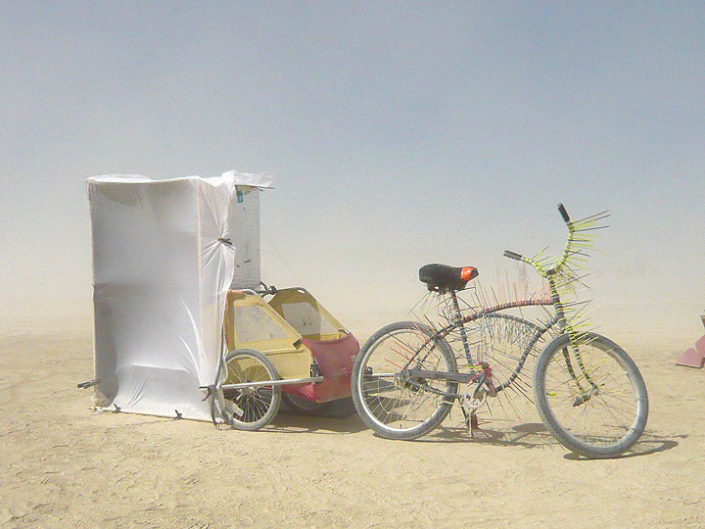
Back side of Koster’s portrait rig enduring a dust storm at Burning Man 2011.
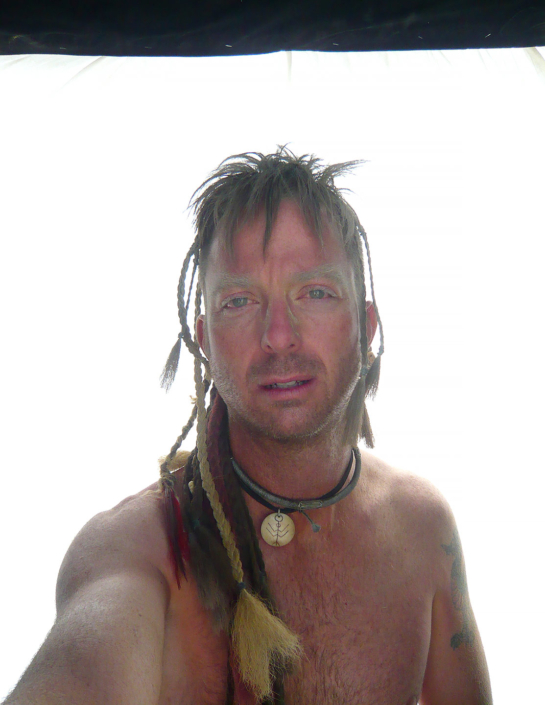
Koster selfie inside his hyper white portrait box taking refuge from a dust storm.
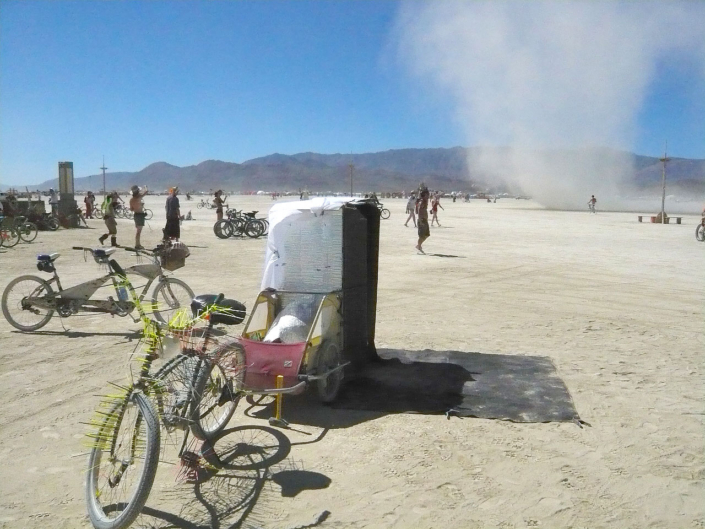
Koster’s hyper white portrait rig with dust devil at Burning Man 2011.
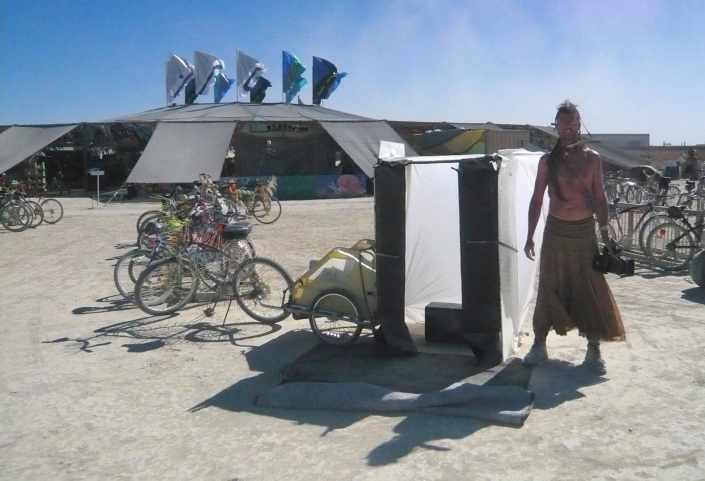
Koster with is camera and hyper white portrait rig next to Center Camp at Burning Man 2011. This was the last day of the Being Seen series.
Portraits on Display

Koster’s portrait rig on display with Being Seen portraits at the Eye Lounge gallery in Phoenix, Az. 2012

Koster’s portrait rig on display with Being Seen portraits at the Eye Lounge gallery in Phoenix, Az. 2012

Three of Koster’s Being Seen portraits and giant cocklebur seedpod on display at Eye Lounge gallery in Phoenix, AZ. 2012
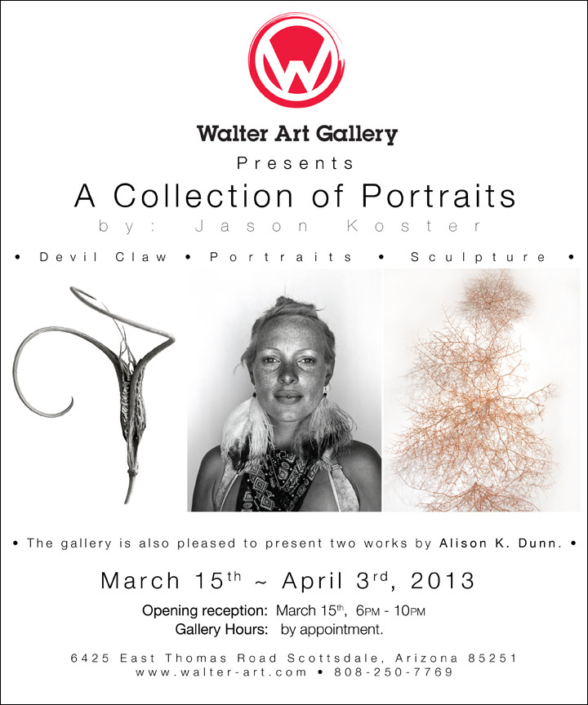
Flier for Koster’s solo show at the Walter Art Gallery in Scottsdale, AZ. 2013
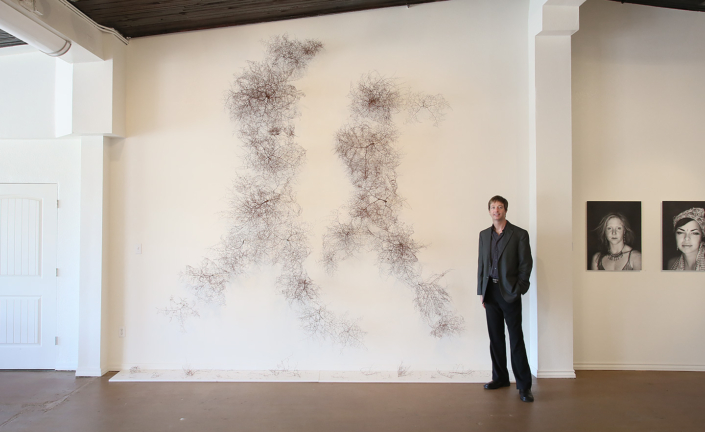
Koster with his skeleton weed wall sculpture and Being Seen portraits at the Walter Art Gallery in Scottsdale, AZ. 2013
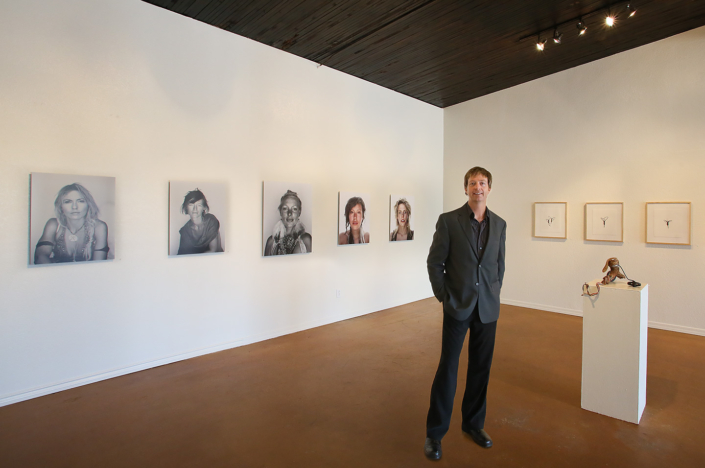
Koster with some Being Seen portraits, Devil’s Claw portraits and small sculpture at the Walter Art Gallery in Scottsdale, AZ. 2013

Koster’s Burning Man bike ‘Spot’ photo bombs Being Seen documentation at the Walter Art Gallery in Scottsdale, AZ. 2013
Final Thoughts

Koster’s Burning Man bike ‘Spot’ in his glory on the Burning Man playa. 2017
Koster’s Being Seen portrait series concluded in 2011.
Koster attended Burning Man a total of 13 times. He skipped 2018 to backpack the John Muir Trail.
2019 was his final year at Burning Man.
